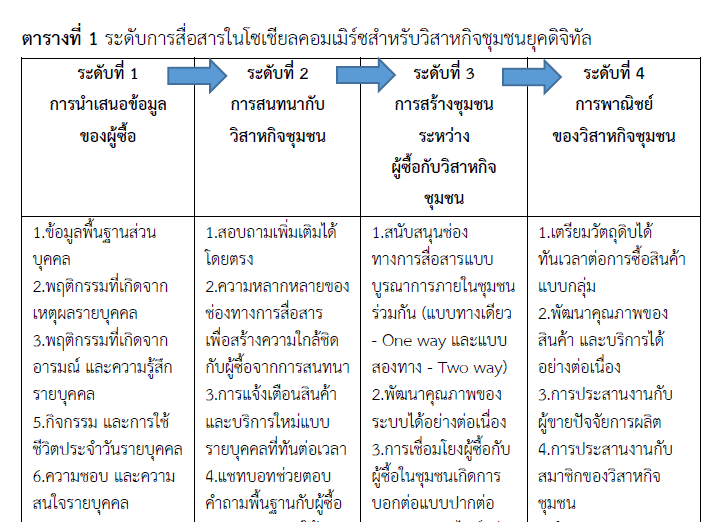โซเชียลคอมเมิร์ซสำหรับวิสาหกิจชุมชน
Main Article Content
บทคัดย่อ
วิสาหกิจชุมชนยุคดิจิทัลสร้างคุณค่าจากการใช้โซเชียลคอมเมิร์ซ เนื่องจากผู้ซื้อในโซเชียลคอมเมิร์ซเพิ่มขึ้นสามารถเข้าถึงได้ง่าย ติดต่อสื่อสารระหว่างกันเกิดการแลกเปลี่ยนข้อมูล ข่าวสารสำคัญเกี่ยวกับการซื้อขายสินค้า และบริการในวิสาหกิจชุมชนของประเทศไทย ด้วยการใช้แชทบอท การตลาดเนื้อหา กลยุทธ์การส่งเสริมการขายแบบอัตโนมัติ และการประสานงานกับผู้ขายปัจจัยการผลิต ส่งเสริมให้วิสาหกิจชุมชนสร้างความสัมพันธ์ที่ดีกับกลุ่มเป้าหมายด้วยการสื่อสารข้อมูล สารสนเทศ และองค์ความรู้ต่าง ๆ เกิดระดับการสื่อสารในโซเชียลคอมเมิร์ซสำหรับดำเนินการวิเคราะห์แนวโน้ม ปรับปรุงการสื่อสารที่ดีจากภาพลักษณ์ตราสินค้า คุณภาพของสินค้าจากความคิดสร้างสรรค์ ออกแบบระดับการสื่อสารในโซเชียลคอมเมิร์ซที่เหมาะสมกับผู้ซื้อที่ชอบสนทนากับผู้ขาย (Conversational Commerce) เพื่อสอบถามรายละเอียดสินค้าและบริการ สร้างความมั่นใจก่อนการตัดสินใจซื้อ วิสาหกิจชุมชนมีวัตถุประสงค์เพื่อปรับรูปแบบการดำเนินงานวิสาหกิจชุมชนให้เป็นพื้นที่การทำงานร่วมกันในรูปแบบออนไลน์ ซึ่งส่งผลดีต่อการจัดการวิสาหกิจชุมชนในยุคดิจิทัลที่ต้องการความสะดวก และรวดเร็วเพื่อรับคำสั่งซื้อผ่านโซเชียลคอมเมิร์ซ และการส่งสินค้า หรือบริการภายใน และภายนอกพื้นที่ให้บริการของวิสาหกิจชุมชน ผู้ซื้อในโซเชียลคอมเมิร์ซมีทางเลือกในการรับข้อมูลข่าวสารจากวิสาหกิจชุมชนและธุรกิจอื่น ๆ ที่ผู้ซื้อติดตาม ปรับรูปแบบการสื่อสารการตลาดแบบบูรณาการผ่านโซเชียลคอมเมิร์ซได้อย่างมีประสิทธิภาพ
Article Details
เอกสารอ้างอิง
จินตนา กาญจนวิสุทธิ์. (2562). ธุรกิจชุมชน: เส้นทางการพัฒนาอาชีพ และการวิจัยในชุมชน (พิมพ์ครั้งที่ 3). มีน เซอร์วิส ซัพพลาย.
นฤศร มังกรศิลา และนุจรี บุรีรัตน์. (2561). การบริหารลูกค้าสัมพันธ์เพื่อให้ได้ข้อมูลย้อนกลับที่ดีจากพาณิชย์อิเล็กทรอนิกส์และโซเชียลคอมเมิร์ซในธุรกิจร้านอาหาร. วารสารจันทรเกษมสาร, 24(46), 65-81.
สำนักงานส่งเสริมวิสาหกิจขนาดกลาง และขนาดย่อม. (2565, 14 กุมภาพันธ์). วิสาหกิจชุมชนกับวิสาหกิจ ขนาดกลาง และขนาดย่อมเหมือนกันไหมน้า?. http://www.sme.go.th/Lists/EditorInput/DispF.spx
Abbott, W., Donaghey, J., Hare, J., & Hopkins, P. (2013). An Instagram is worth a thousand words: an industry panel and audience Q&A. Library Hi Tech News, 30(7), 1-6.
Abed, S. S. (2020). Social commerce adaption using TOE Framework: An empirical investigation of Saudi Arabian SMEs. International Journal of Information Management, 53.
Ahmad, S. N., & Laroche, M. (2017). Analyzing electronic word of mouth: A social commerce construct. International Journal of Information Management, 37(3), 202-213.
Basu, S. (2018). Information search in the internet markets: Experience versus search goods. Electronic Commerce Research and Applications. 30(1), 25-37.
Bhattacharyya, S., & Bose, I. (2020). S-commerce: Influence of Facebook likes on purchases and recommendations on a linked e-commerce site. Decision Support Systems, 138.
Charlton, A. B., & Cornwell, T. B. (2019). Authenticity in horizontal marketing partnerships: A better measure of brand compatibility. Journal of Business Research, 100, 279-298.
Cheung, C. M. K., Lee, M. K. O., & Rabjohn, N. (2008). The Impact of electronic word of mouth: the adoption of online opinions in online customer communities. Internet Research, 18(3), 229-247.
Cui, Y., Mou, J., & Liu, Y. (2018). Knowledge mapping of social commerce research: a visual analysis using CiteSpace. Springer Science+Business Media.
Dholakia, U. M., Blazevic, V., Wiertz, C., & Algsheimer, R. (2009). Communal service delivery: How customers benefit from participation in firm-hosted virtual P3 communities. Journal of Service Research, 12(2), 208-226.
Friedrich, T., Schlauderer, S., & Overhage, S. (2019). The impact of social commerce feature richness on website stickiness through cognitive and affective factors: An experimental study. Electronic Commerce Research and Applications, 36.
Hajli, M. (2022, June 16). Social Commerce adoption model. In Proceeding of the UK Academy of Information Systems Conference. http://aisel.aisnet.org/ukais2012/16
Han, H., & Trimi, S. (2017). Social Commerce Design: A Framwork and Application. Journal of Theoretical and Applied Electronic Commerce Research, 12(3), 50-68.
Huang, Z., & Benyoucef, M. (2017). The effects of social commerce design on comsumer purchase decision-making: An empirical study. Electronic Commerce Research and Applications. 25, 40-58.
Kizildag, M., Altin, M., Ozedmir, O., and Demirer, I. (2017). What do we know about social media firms’ financial outcomes so far?. Journal of Hospitality and Tourism Technology, 8(1), 39-54.
La Rose, J. T. (2013). Reading YouTube for social work (Doctoral dissertation). Available from ProQuest Dissertations & Theses Global database. (UMI No. 3666099)
Lin, X., Li, Y., & Wang, X. (2017). Social commerce research: Definition, research themes and trends. International Journal of Information Management. 37, 190-201.
Madias, K., & Szymkowiak, A. (2022). Functionalities of Social Commerce used by SME during Pandemic. International Journal of Marketing, Communication and New Media.
Molinillo, S., Anaya-Sánchez, R., & Liébana-Cabanillas, F. (2019). Analyzing the effect of social support and community factors on customer engagement and its impact on loyalty behaviors toward social commerce websites. Computers in Human Behavior.
Osatuyi, B., & Qin, H. (2018). How vital is the role of affect on post-adoption behaviors? An examination of social commerce users. International Journal of Information Management. 40, 175-185.
Prachachat. (2565, 1 กรกฎาคม). ขาขึ้น โซเชียลคอมเมิร์ซ ช้อปไลน์ผุดฟีเจอร์ใหม่. Prachachat. https://www..net/ict/news-706596
Positioning. (2565, 1 มิถุนายน). รู้จัก Conversational Commerce คนไทยซื้อของออนไลน์ผ่านแชทมากที่สุดในโลก. Positioningmag. https://positioningmag.com/125417
Puerta, P., Laguna, L., Vidal, L., Ares, G., Fiszman, S. & Tárrega, A. (2020). Co-occurrence networks of Twitter content after manual or automatic processing. A case-study on “gluten-free. Food Quality and Preference, 86.
Sharda, N. (2021, July 23). Serving food from the cloud: financial growth strategy.http://www.toptal.com
Statista. (2022, June 26). Number of social network users in selected countries in 2020 and 2025. https://www.statista.com/statistics/278341/number-of-social-network-users-in-selected-countries/
Sun, Y., Shao, X., Li, X., Guo, Y., & Nie, K. (2020). A 2020 perspective on “How live streaming influences purchase intentions in social commerce: An IT affordance perspective”. Electronic Commerce Research and Applications, 40.
Tang, J., & Zhang, P. (2018). The impact of atmospheric cues on consumers’ approach and avoidance behavioral intentions in social commerce websites. Computers in Human Behavior.
Turban, E., Bolloju, N., & Liang, T. P. (2010). Social Commerce: An E-Commerce Perspective. ICEC10.
Vongsraluang, N., & Bhatiasevi, V. (2016). The determinants of social commerce system success for SMEs in Thailand. Information Development, 33(1), 80–96. doi:10.1177/0266666916639632
Wang, X. (2020). What tweets and retweets on twitter can tell for the restaurant industry: A big-data approach (Doctoral dissetation). Available from ProQuest Dissertations & Theses database. (UMI No. 27834685)
Wang, X., Lin, X., & Spencer, M. K. (2019). Exploring the effects of extrinsic motivation on consumer behaviors in social commerce: Revealing consumers’ perception of social commerce benefits. International Journal of Information Management. 45, 163-175.
Xiang, L., Zheng, X., Lee, M. K. O., & Zhao, D. (2019). Exploring consumers’ impulse buying behavior on social commerce plateform: The role of parasocial interaction.International Journal of Information Management. 36, 333-347.
Yagci, A. I. & Das, S. (2018). Measuring deciding-level information quality in online reviews. Electronic Commerce Research and Applications. 30(1), 102-110.
Yu, C.-E., & Sun, R. (2019). The role of Instagram in the UNESCO’s creative city of gastronomy: A case study of Macau. Tourism Management, 75, 257–268.


